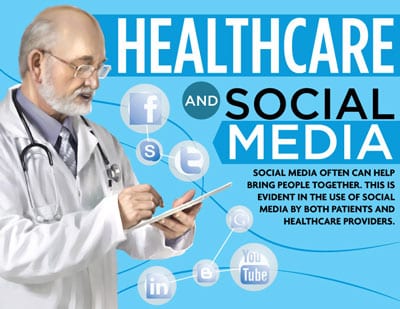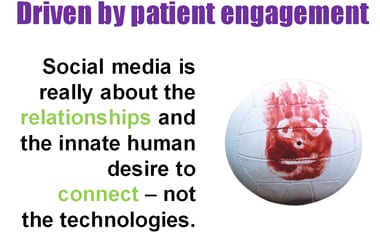Healthcare Social Media: Directing the Conversation
 We know, we know – you’ve heard it many times: your healthcare organization needs an active social media presence. There’s plenty of information out there about best practices for healthcare social media (#HCSM), so the last thing you need is another how-to blog post. Instead, let’s take a look at how people say they’re using social media in matters related to their health, and how providers are
We know, we know – you’ve heard it many times: your healthcare organization needs an active social media presence. There’s plenty of information out there about best practices for healthcare social media (#HCSM), so the last thing you need is another how-to blog post. Instead, let’s take a look at how people say they’re using social media in matters related to their health, and how providers are
joining – even leading – the conversation.
To quote the creators of this infographic that illustrates social media in healthcare, “People will talk about anything on Facebook – even their surgery or their doctor.” Those are important conversations to know about, and it’s equally important to make your own messages heard. With that in mind, here’s our take on the key findings presented in the infographic:
Patients can share their own health experiences freely…and many do. One in four people will post socially about health experiences or updates, and one in six will post reviews about factors related to those experiences, including doctors and treatments (yet another underlying incentive to make sure your customer service and/or patient care is at the top of its game).
Also worth noting is video shares. When we wrote last year about healthcare marketers expanding reach with online videos, we reported that 32 percent of people watch health videos online. Research shows at least half of those people don’t just watch – they also share, provided they feel it’s something others want or need to see. Take, for example, the popular Cleveland Clinic video called “Empathy” – no doubt you’ve seen or heard of it, since it made the rounds on several social sites thanks to social sharing:
On a side note, the Cleveland Clinic video is also a great example of emotional branding in healthcare, but that’s a whole other blog topic (read it now!).
Of course, smaller scale messages get noticed and spread on social media, too. To build awareness for a fundraiser, blood drive, health fair or any other event your organization is involved in, post about it socially and encourage your followers to share. You won’t waste your time – research shows “supporting health-related causes” is the number one answer when people are asked which health-related topics they’ll talk about on social media.
Blog. Blog. Blog. Far too few healthcare providers are doing it. What a great opportunity for you to emerge as a thought leader in various dialogues related to healthcare! Yes, it needs to be good content, and yes, it takes planning, processes, oversight, people and time. But if you can become a trustworthy voice of healthcare information in a sea of relative silence, by all means, you should.
Just one blog will do, but some take it further with multiple blogs, like Holy Cross Hospital in Ft. Lauderdale (a separate blog for each service line), and of course, the many blogs of Mayo Clinic, a well-known thought leader in #HCSM. Mayo Clinic’s blogs incorporate patient stories, podcasts, news and research, student perspectives, guest bloggers and more.
People trust healthcare providers more than any other group that’s writing and posting professionally about health-related topics. Among them, doctors are trusted the most (60 percent), followed closely by nurses (56 percent) and hospitals (55 percent). Providers outrank patient advocates, pharmacies and drug manufacturers, insurers, fitness centers and other patients when it comes to trustworthy sources for accurate, helpful online information about health-related issues.
Encourage your expert care teams to contribute to your organization’s blog. Share each contribution on your social media outlets, and make it obvious at the newsfeed-level that it’s authored by a doctor, nurse, therapist or whatever the case may be. This will increase the likelihood that people recognize it early on as a reputable resource, and therefore worth sharing. Be sure to feature clinicians in your online videos, too.
Take time to provide the information people really want, and they’ll take time to listen and share. During a shooting rampage a few years ago in central Texas, Scott & White Healthcare tweeted ongoing, real-time updates on ER access, hospital status, Red Cross news and more. Knowing what information people wanted to find at that moment in time – and delivering it in full throttle – boosted the healthcare system’s Twitter following by nearly 80 percent.
Another powerful example: in the aftermath of Haiti’s 2010 earthquake, Rush University Medical Center sent a team of doctors to help. The doctors provided first-hand accounts, and the situation unfolded across a new category on the Rush News Blog: Mission to Haiti. In the wake of a tragedy, people want to know what’s going on and how things are being handled, so this was a great way to share what their doctors were seeing and doing.
Those two examples are disaster-related, but the concept applies to any content you share. The key is knowing what people want from you, and delivering it when and where they’re looking for it.
Do you have any #HCSM success stories or insights of your own to share? If so, let us hear from you in the comments! We’d love to hear from patients and providers alike.

 Later this week, I will moderate an interactive panel for
Later this week, I will moderate an interactive panel for  You’ve seen them on blogs as handy visual aids that spotlight keywords from page content. Word clouds make it easy for web surfers to determine if any given blog or post interests them enough to keep reading. But for marketers, word clouds offer communication tools that can be used outside the blog as well.
You’ve seen them on blogs as handy visual aids that spotlight keywords from page content. Word clouds make it easy for web surfers to determine if any given blog or post interests them enough to keep reading. But for marketers, word clouds offer communication tools that can be used outside the blog as well.